备注
前往结尾 下载完整示例代码。或在浏览器中通过 Binder 运行此示例。
使用滚动球算法估计背景强度#
滚动球算法估计灰度图像在不均匀曝光情况下的背景强度。它经常用于生物医学图像处理,并由Stanley R. Sternberg在1983年首次提出 [1]。
该算法作为一个过滤器工作,并且非常直观。我们将图像想象为一个表面,该表面上的每个像素位置都堆叠着单位大小的块。块的数量,从而表面高度,由像素的强度决定。为了在所需(像素)位置获取背景的强度,我们想象将一个球浸入到所需位置的表面下。一旦它完全被块覆盖,球的顶点就决定了该位置的背景强度。然后我们可以将这个球在表面下方滚动,以获取整个图像的背景值。
Scikit-image 实现了一个通用的滚动球算法版本,它不仅允许你使用球体,还可以使用任意形状作为核,并且适用于 n 维图像。这使你可以直接过滤 RGB 图像,或沿着任何(或所有)空间维度过滤图像堆栈。
经典滚球#
在 scikit-image 中,滚动球算法假设你的背景具有低强度(黑色),而特征具有高强度(白色)。如果这是你的图像的情况,你可以直接使用过滤器,如下所示:
import matplotlib.pyplot as plt
import numpy as np
import pywt
from skimage import data, restoration, util
def plot_result(image, background):
fig, ax = plt.subplots(nrows=1, ncols=3)
ax[0].imshow(image, cmap='gray')
ax[0].set_title('Original image')
ax[0].axis('off')
ax[1].imshow(background, cmap='gray')
ax[1].set_title('Background')
ax[1].axis('off')
ax[2].imshow(image - background, cmap='gray')
ax[2].set_title('Result')
ax[2].axis('off')
fig.tight_layout()
image = data.coins()
background = restoration.rolling_ball(image)
plot_result(image, background)
plt.show()
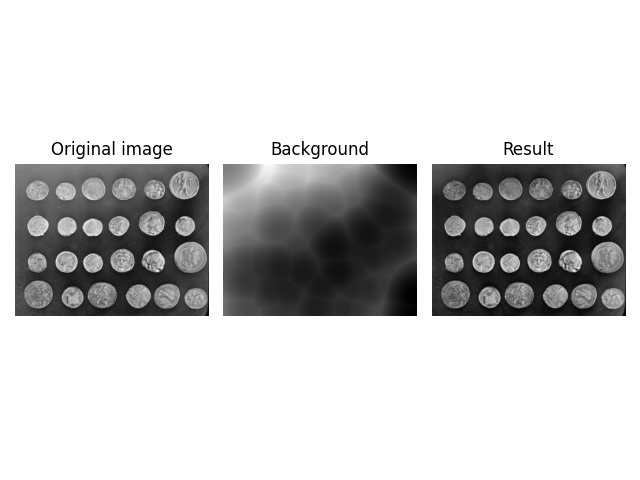
白色背景#
如果你在亮背景上有暗特征,你需要在将图像传递给算法之前反转图像,然后再反转结果。这可以通过以下方式实现:
image = data.page()
image_inverted = util.invert(image)
background_inverted = restoration.rolling_ball(image_inverted, radius=45)
filtered_image_inverted = image_inverted - background_inverted
filtered_image = util.invert(filtered_image_inverted)
background = util.invert(background_inverted)
fig, ax = plt.subplots(nrows=1, ncols=3)
ax[0].imshow(image, cmap='gray')
ax[0].set_title('Original image')
ax[0].axis('off')
ax[1].imshow(background, cmap='gray')
ax[1].set_title('Background')
ax[1].axis('off')
ax[2].imshow(filtered_image, cmap='gray')
ax[2].set_title('Result')
ax[2].axis('off')
fig.tight_layout()
plt.show()

在减去亮背景时要小心不要成为整数下溢的受害者。例如,这段代码看起来是正确的,但可能会遭受下溢,导致不需要的伪影。你可以在可视化的右上角看到这一点。
image = data.page()
image_inverted = util.invert(image)
background_inverted = restoration.rolling_ball(image_inverted, radius=45)
background = util.invert(background_inverted)
underflow_image = image - background # integer underflow occurs here
# correct subtraction
correct_image = util.invert(image_inverted - background_inverted)
fig, ax = plt.subplots(nrows=1, ncols=2)
ax[0].imshow(underflow_image, cmap='gray')
ax[0].set_title('Background Removal with Underflow')
ax[0].axis('off')
ax[1].imshow(correct_image, cmap='gray')
ax[1].set_title('Correct Background Removal')
ax[1].axis('off')
fig.tight_layout()
plt.show()
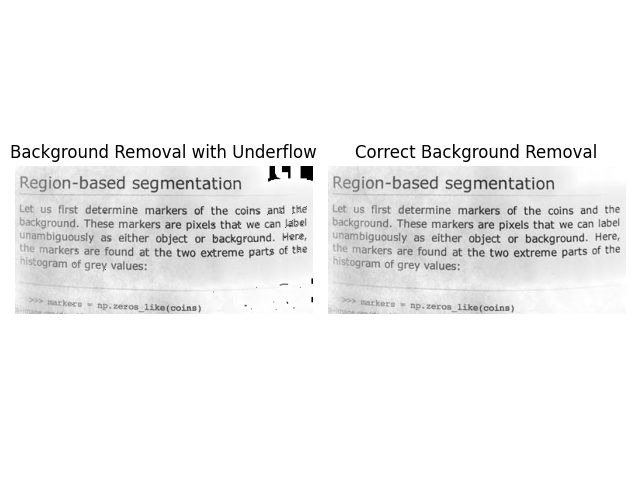
图像数据类型#
rolling_ball 可以处理除 np.uint8 以外的数据类型。你可以以相同的方式将它们传递给函数。
image = data.coins()[:200, :200].astype(np.uint16)
background = restoration.rolling_ball(image, radius=70.5)
plot_result(image, background)
plt.show()

然而,如果你使用的是已经归一化到 [0, 1] 的浮点图像,你需要小心。在这种情况下,球的大小会比图像的强度大得多,这可能会导致意外的结果。
image = util.img_as_float(data.coins()[:200, :200])
background = restoration.rolling_ball(image, radius=70.5)
plot_result(image, background)
plt.show()

因为 radius=70.5 远大于图像的最大强度,有效核大小显著减小,即只有球的一小部分(大约 radius=10)在图像中滚动。你可以在下面的 高级形状 部分找到这种奇怪效果的再现。
要获得预期的结果,您需要降低内核的强度。这是通过使用 kernel 参数手动指定内核来完成的。
注意:半径等于椭圆的一个半轴的长度,即全轴的 一半 。因此,核形状乘以二。
normalized_radius = 70.5 / 255
image = util.img_as_float(data.coins())
kernel = restoration.ellipsoid_kernel((70.5 * 2, 70.5 * 2), normalized_radius * 2)
background = restoration.rolling_ball(image, kernel=kernel)
plot_result(image, background)
plt.show()

高级形状#
默认情况下,rolling_ball 使用一个球形核(惊讶吧)。有时,这可能过于局限——如上例所示——因为强度维度与空间维度相比具有不同的尺度,或者因为图像维度可能有不同的含义——其中一个维度可能是图像堆栈中的堆栈计数器。
为了解决这个问题,rolling_ball 有一个 kernel 参数,允许你指定要使用的核。核必须与图像具有相同的维度(注意:是维度,不是形状)。为了帮助创建核,skimage 提供了两个默认核。ball_kernel 指定了一个球形核,并作为默认核使用。ellipsoid_kernel 指定了一个椭球形核。
image = data.coins()
kernel = restoration.ellipsoid_kernel((70.5 * 2, 70.5 * 2), 70.5 * 2)
background = restoration.rolling_ball(image, kernel=kernel)
plot_result(image, background)
plt.show()
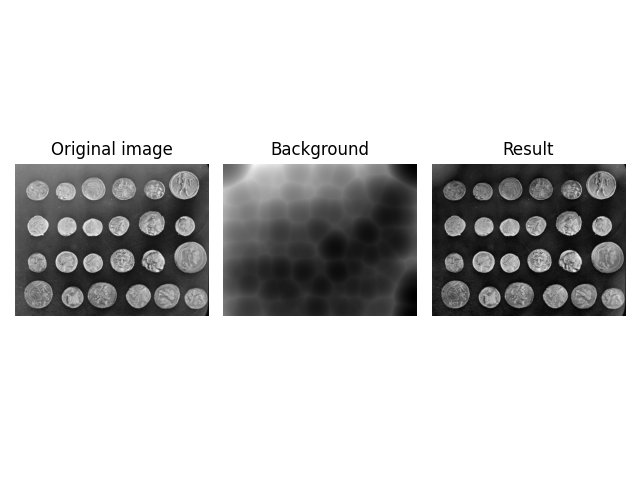
你也可以使用 ellipsoid_kernel 来重现之前意外的结果,并看到有效(空间)滤波器尺寸被减小了。
image = data.coins()
kernel = restoration.ellipsoid_kernel((10 * 2, 10 * 2), 255 * 2)
background = restoration.rolling_ball(image, kernel=kernel)
plot_result(image, background)
plt.show()

高维#
rolling_ball 的另一个特点是你可以直接将其应用于更高维度的图像,例如,通过共聚焦显微镜获得的图像堆栈。核的维度数量必须与图像的维度匹配,因此核的形状现在是三维的。
image = data.cells3d()[:, 1, ...]
background = restoration.rolling_ball(
image, kernel=restoration.ellipsoid_kernel((1, 21, 21), 0.1)
)
plot_result(image[30, ...], background[30, ...])
plt.show()
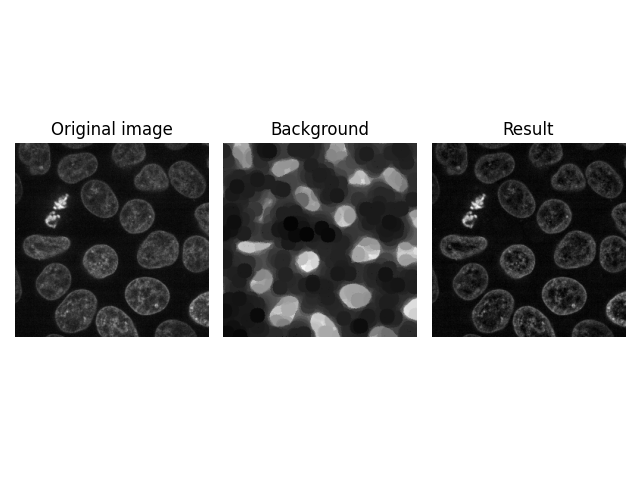
内核大小为1不会沿此轴进行过滤。换句话说,上述过滤器分别应用于堆栈中的每个图像。
然而,你也可以通过指定一个非1的值,同时沿着所有三个维度进行过滤。
image = data.cells3d()[:, 1, ...]
background = restoration.rolling_ball(
image, kernel=restoration.ellipsoid_kernel((5, 21, 21), 0.1)
)
plot_result(image[30, ...], background[30, ...])
plt.show()

另一种可能性是沿着平面轴(z-stack轴)过滤单个像素。
image = data.cells3d()[:, 1, ...]
background = restoration.rolling_ball(
image, kernel=restoration.ellipsoid_kernel((100, 1, 1), 0.1)
)
plot_result(image[30, ...], background[30, ...])
plt.show()

1D 信号滤波#
作为 rolling_ball 的 n 维特性的另一个例子,我们展示了一个针对 1D 数据的实现。在这里,我们感兴趣的是去除 ECG 波形的背景信号,以检测显著的峰值(高于局部基线的值)。较平滑的峰值可以通过较小的半径值来去除。
x = pywt.data.ecg()
background = restoration.rolling_ball(x, radius=80)
background2 = restoration.rolling_ball(x, radius=10)
plt.figure()
plt.plot(x, label='original')
plt.plot(x - background, label='radius=80')
plt.plot(x - background2, label='radius=10')
plt.legend()
plt.show()
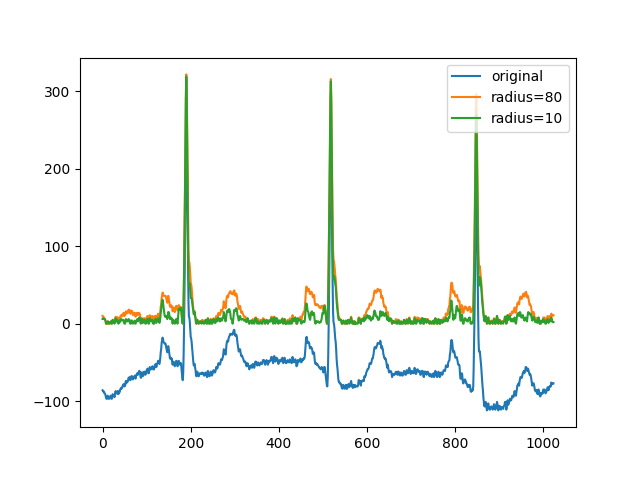
脚本总运行时间: (0 分钟 6.955 秒)
